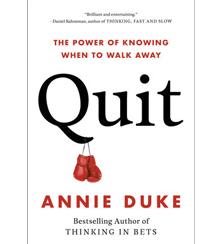Could it be quitting time?
Annie Duke’s wise new book provides courage and insight about when to walk away.

Quit: The Power of Knowing When to Walk Away
by Annie Duke, Portfolio, 2022
Are you planning to read this entire book review? Or have you already chosen a point at which you’ll stop and move on to something else?
If you have considered when you might opt out, you may already understand the key lesson in Annie Duke’s new book, Quit: The Power of Knowing When to Walk Away. “Contrary to popular belief, winners quit a lot. That’s how they win,” Duke writes. Her savvy book recognizes the power of quitting at the ideal moment, and she shares methods for choosing this moment more effectively.
Duke, the author of recent bestsellers Thinking in Bets and How to Decide, has a backstory that endows her work with a certain allure. After a medical complication forced her to abandon her pursuit of an academic career, she pivoted to what became a spectacularly successful poker career, winning more than US$4 million and the World Series of Poker Tournament of Champions. In Quit, she draws insights from her poker background, years of scholarly research, and case studies from the world of business.
The book tackles a challenge that proves stubbornly difficult for most people. Letting go of anything is hard, especially at a time when pundits tout the power of grit, building resilience, and toughing it out. Duke provides permission to see quitting as not only viable but often preferable, and she explains why people rarely give up at the right time. “Quitting is hard, too hard to do entirely on our own,” she writes. “We as individuals are riddled by the host of biases, like the sunk cost fallacy, endowment effect, status quo bias, and loss aversion, which lead to escalation of commitment. Our identities are entwined in the things that we’re doing. Our instinct is to want to protect that identity, making us stick to things even more.” These biases—some of them unconscious—prompt us to stick with jobs that have lost their appeal or value; hold on to losing stocks long after an inner voice screams “Sell!”; or endure myriad other situations that no longer serve us.
Our biases prompt us to stick with jobs that have lost their appeal or value; hold on to losing stocks long after an inner voice screams ‘Sell!’; or endure myriad other situations that no longer serve us.
Duke focuses far more on the thinking behind the decision to “quit or grit” rather than on the decision’s final outcomes. She discusses mountaineers who survived arduous treks only because they headed back after falling behind on their schedule, an example of what she calls “expertly exercising the option to quit,” and she unpacks the complicated cognitive process of assessing the potential gains and losses of persisting down one fixed path compared to another. This includes considering the EV, or “expected value,” of the established path, compared to the EV of the alternative.
One example of quitting Duke cites is the story of Stewart Butterfield, who helped create a successful online game called Glitch. But after discovering that diehard users comprised less than 5% of the game’s followers, and that growing this base by spending on customer acquisition was far too expensive to achieve profitability, he folded the company, shocking his investors and other founders. Butterfield chose to convert the team’s internal communication platform—then referred to as a “searchable log of all communications and knowledge”—into a standalone productivity tool. That pivot paid off with the IPO and subsequent purchase of his unicorn, Slack.
Duke advises taking a pragmatic and systemic approach to how you assess a decision, which include the potential benefits of changing course: “What matters is maximizing your expected value across all the things you start, across all of your mental accounts,” she writes.
Among Duke’s insights, she stresses the following:
• Use a “quitting coach”—possibly a friend or confidante—to provide outside perspective into dispassionately weighing tough choices.
• Look beyond any immediate situation where you are influenced too strongly by short-term impulses. Duke’s poker career taught her to prioritize her long-term play over any one hand or evening, knowing to walk away when her game was off. “Local goals can impede us from acting in a way that embodies the reality that life is one long poker game,” she writes.
• Calculate the expected value of alternate paths when the legacy of sunk costs may pressure you to seek compensation of prior investments. “Your goals should change because the world changes and you change,” she writes.
• Understand that “quitting early” is almost always superior to postponing a prompt departure, although “quitting on time will usually feel like quitting too early.” Her core message is to look forward in time rather than back, because quitting on time gets you “to where you want to go faster.”
• Recognize your stubborn emotional anchors. She likens these heavy emotions to a butcher who “gaffs” the scale by putting her thumb on it. She cites the “endowment bias” by which individuals double down on losing positions in the face of contrary evidence; they fail to quit when they should because their losing position has become core to their identity.
•Give yourself permission to try new things as a means of trusting the process and experimenting. Duke cites how comedian Richard Pryor would develop new material that largely bombed at first, until he discovered which bits of material were resonating with live audiences, and which he could discard.
Ultimately, Duke’s book is a wise guide to thinking more holistically about how to choose your best path forward, regardless of where you are in life. Duke gives you permission to swap out what you sense is a flawed journey and replace it with one that will bring you more promise.
Author profile:
- Tom Ehrenfeld is a freelance writer and editor based in Cambridge, Mass. Formerly a writer/editor with Inc. magazine and Harvard Business Review, he is also the author of The Startup Garden. He has written extensively about lean enterprise; nine books that he has edited have won the Shingo Publication Award.





